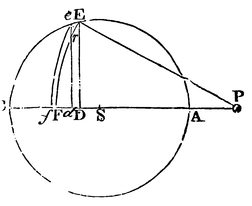 is generated by the revolution of the arc FE, and is cut any where, as in r, by the line de, the annular part of the superficies generated by the revolution of the arc rE will be as the lineola Dd, the radius of the sphere PE remaining the same; as Archimedes has demonstrated in his Book of the Sphere and Cylinder. And the force of this superficies exerted in the direction of the lines PE or Pr situate all round in the conical superficies, will be as this annular superficies itself; that is as the lineola Dd, or, which is the same, as the rectangle under the given radius PE of the sphere and the lineola Dd; but that force, exerted in the direction of the line PS tending to the centre S, will be less in the ratio PD to PE, and therefore will be as PD Dd. Suppose now the line DF to be divided into innumerable little equal particles, each of which call Dd, and then the superficies FE will be divided into so many equal annuli, whose forces will be as the sum of all the rectangles PD Dd, that is, as ½PF² - ½PD², and therefore as DE². Let now the superficies FE be drawn into the altitude Ff; and the force of the solid EFfe exerted upon the corpuscle P will be as DE² Ff; that is, if the force be given which any given particle as Ff exerts upon the corpuscle P at the distance PF. But if that force be not given, the force of the solid EFfe will be as the solid DE² Ff and that force not given, conjunctly. Q.E.D.
is generated by the revolution of the arc FE, and is cut any where, as in r, by the line de, the annular part of the superficies generated by the revolution of the arc rE will be as the lineola Dd, the radius of the sphere PE remaining the same; as Archimedes has demonstrated in his Book of the Sphere and Cylinder. And the force of this superficies exerted in the direction of the lines PE or Pr situate all round in the conical superficies, will be as this annular superficies itself; that is as the lineola Dd, or, which is the same, as the rectangle under the given radius PE of the sphere and the lineola Dd; but that force, exerted in the direction of the line PS tending to the centre S, will be less in the ratio PD to PE, and therefore will be as PD Dd. Suppose now the line DF to be divided into innumerable little equal particles, each of which call Dd, and then the superficies FE will be divided into so many equal annuli, whose forces will be as the sum of all the rectangles PD Dd, that is, as ½PF² - ½PD², and therefore as DE². Let now the superficies FE be drawn into the altitude Ff; and the force of the solid EFfe exerted upon the corpuscle P will be as DE² Ff; that is, if the force be given which any given particle as Ff exerts upon the corpuscle P at the distance PF. But if that force be not given, the force of the solid EFfe will be as the solid DE² Ff and that force not given, conjunctly. Q.E.D.
PROPOSITION LXXX. THEOREM XL.
- If to the several equal parts of a sphere ABE described about the centre S there tend equal centripetal forces; and from the several points D in the axis of the sphere AB in which a corpuscle, as F, is placed, there be erected the perpendiculars DE meeting the sphere in E, and if in those perpendiculars the lengths DN be taken as the quantity , and as the force which a particle of the sphere situate in the axis exerts at the distance PE upon the corpuscle P conjunctly; I say, that the whole force with which the corpuscle P is attracted towards the sphere is as the area ANB, comprehended under the axis of the sphere AB, and the crrve line ANB, the locus of the point N.
For supposing the construction in the last Lemma and Theorem to stand, conceive the axis of the sphere AB to be divided into innumerable equal particles Dd, and the whole sphere to be divided into so many sphærical concavo-convex laminæ EFfe; and erect the perpendicular dn. By the last Theorem, the force with which the laminæ EFfe attracts the corpuscle P is as DE² Ff and the force of one particle exerted at the


